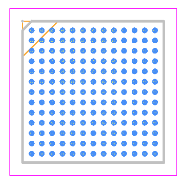10M04SCU169C8G FPGAs: Features, Applications and Datasheet
2024-11-18 11:00:33 419
10M04SCU169C8G Description
The 10M04SCU169C8G is a programmable logic device (CPLD/FPGA) manufactured by Intel/Altera (now Intel Programmable Solutions Group). It is packaged in the UBGA-169 package, has a gross weight of 39 grams, an operating temperature range of 0°C to +85°C, and features a logic cell count of 4000, a logic array block count of 250, and an embedded block RAM (EBR) of 193536 bits. It also has 130 I/Os and a supply voltage range of 2.85V~3.465V.
10M04SCU169C8G Features
Advanced microprocessor technology: The controller adopts advanced microprocessor technology, which is able to quickly process a large amount of data coming from sensors and make timely response.
High stability: after strict quality inspection and environmental adaptability test, it can work stably in different environments.
Highly scalable: the sensors can monitor a variety of environmental parameters at the same time, and can expand the monitoring range and functions by adding or replacing different sensors.
10M04SCU169C8G Applications
The 10M04SCU169C8G can be used in a wide variety of applications that require programmable logic solutions, including but not limited to:
Communication field: for realizing high-speed data transmission and signal processing.
Industrial automation: for controlling various equipment and systems to improve production efficiency.
Consumer electronics: Used in smart homes, smart wearable devices, etc. to provide flexible control and data processing capabilities.
10M04SCU169C8G CAD Model
Symbol

Footprint

3D Model


10M04SCU169C8G Manufacturer
Intel is one of the world's leading semiconductor companies, the following is a brief introduction:
1. Company Overview
Founded and Location: Intel was founded in 1968 and is headquartered in Santa Clara, California, USA.
Founder: The founders of the company are Robert Noyce and Gordon Moore, who were initially known for their production of memory chips, but later shifted to the production of microprocessors and became one of the largest semiconductor companies in the world.
2. History
In 1971, Intel launched the world's first microprocessor, which laid the foundation for the subsequent computer and Internet revolution.
Intel has continued to innovate in the field of microprocessors, launching a number of landmark products, such as the 8086, 80286, 80386, etc., and gradually dominating the personal computer and server markets.
In recent years, Intel has also sought new growth opportunities in areas such as cloud computing, artificial intelligence, and 5G, and has increased its investment in research and development of new technologies and products.
3. Products and Business
Main Products: Intel's main product is the microprocessor (CPU), which is the brain of a computer and is responsible for performing various computing tasks. In addition, the company also produces solid state drives, chipsets, networking equipment and other semiconductor-related products.
Business Areas: Intel's business covers a wide range of areas such as personal computers, data centers, IoT devices, communications equipment and automobiles, and is committed to providing a broad portfolio of innovative server products, systems and solutions to help companies achieve growth and strengthen market competitiveness.
4. Market Position and Competition
As one of the leaders in the semiconductor industry, Intel occupies a significant position worldwide. Its processors have a high market share in the personal computer and server markets.
Intel faces competition from a number of rivals, including AMD (Super Micro Semiconductor) and NVIDIA in the United States, as well as from Samsung, TSMC and other companies.
In short, Intel is a semiconductor company with a deep history and strong technical capabilities, and has played an important role in driving computing innovation and semiconductor technology development.
10M04SCU169C8G FAQs
Why is there no “Dual Compressed Images” option in the Altera On-Chip Flash IP Core for 10M04SCU169C8G?
Answer: This is because the 10M04SCU169C8G (compact type 10mxxxsc) does not support dual mirroring. Please refer to the menu in the device overview for more information.
Does the 10M04SCU169C8G support remote upgrades?
Answer: According to some information, the 10M04SCU169C8G does support remote updates, but without a secure factory mirror during the update process, the FPGA will have to be reprogrammed via JTAG in the event of an update interruption.
What are the possible failures of the 10M04SCU169C8G during power-up or reset to self-test completion?
Answer: Possible faults include the host can not be powered up, no display at power on, self-test reporting error or crash, and repeated reboot. These faults may be related to hardware such as power supply, motherboard, CPU, memory, display card, etc., or may be related to BIOS settings.
What abnormalities may occur during startup or shutdown of the 10M04SCU169C8G?
Answer: Possible anomalies include crashing, reporting errors, black screen, and repeated reboots during startup, as well as crashing or reporting errors when shutting down the operating system. These anomalies may be related to BIOS settings, boot files, device drivers, operating system/application configuration files, and so on.
How do I choose the right FPGA or CPLD replacement?
Answer: When choosing an FPGA or CPLD replacement, you need to consider factors such as application needs, performance requirements, cost, and supply chain. It is recommended to carefully compare the specifications, performance, and price of different products and select an alternative that meets your needs.




